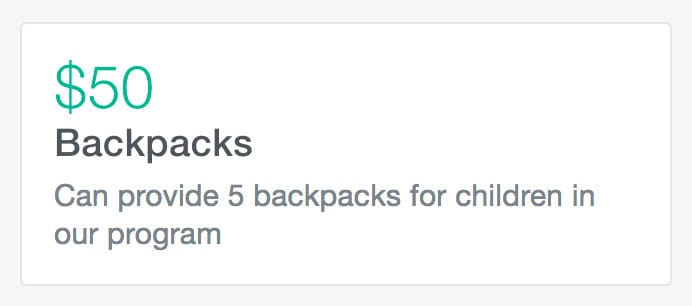Giving Levels are the preset amounts you present to donors on donation forms. These are great at displaying impact transparency by giving the donor an idea of what their gift can actually do. The true goal of a giving level is to elicit an emotional response and incrementally increase average gift size in the process.
As an example: Donor A has been with the organization for 4 years and gives $40 each year just before the holidays. This year, you have added giving levels to your form, and the lowest amount is $50:

Donor A really likes the idea of providing physical backpacks to the kids in the program, and decides this year he will give $50 instead of the $40 he usually gives.
Did you notice the wording of the giving level above? By saying “can provide,” we ensure the gift isn’t a restricted fund. Other strategic word choices include “equivalent to” or “worth.” Many times, giving the donor a sense of their gift’s impact is enough to increase their support, but we do see higher increases when the funds are restricted and going in-full to the outcome you describe.
How does one come up with their giving levels? If you are new to online fundraising or a new nonprofit without historic data, then it’s good to make educated guesses and adjust over time. If you do have access to a year or more of donation data, then you can use a calculation to see the best results:
Step 1: Bucketing
Bucket your donations into 3-5 categories, ranging from low to high. For example, if your nonprofit had 400 donations last year, ranging from $5 all the way up to $1200, choose to bucket into 5 categories, where low is $5-$20, mid-low is $21-$40, mid is $41-$100, mid-high is $101-$500, and high is anything over $500.
Step 2: Average
Take an average of each grouping to understand each profile’s average gift size, i.e. low is $12, mid-low is $30, mid is $75, mid-high is $200, and high is $650.
Step 3: Add 20% and Impact
For each average, add 20% to the amount (feel free to round up!) and come up with an impact related description for each. With the above example, your giving levels would be: Low $15, $36, $90, $240, & $780. Descriptions should give prospective donors an idea about what outcome their gift can have, and outcomes that have a good chance of eliciting a personal connection or emotional response are best.
Donors generally do not decrease their giving amounts over time — they tend to stay steady or stop, so don’t worry about giving levels lowering your larger supporters’ donations. They give you a solid chance at increasing some donors’ gifts and help from the onset of the donor journey by creating a personal connection with the cause. This is paramount in your retention efforts, and, combined with good follow up and stewardship practices, set the stage for making a donor truly feel involved, as they should!